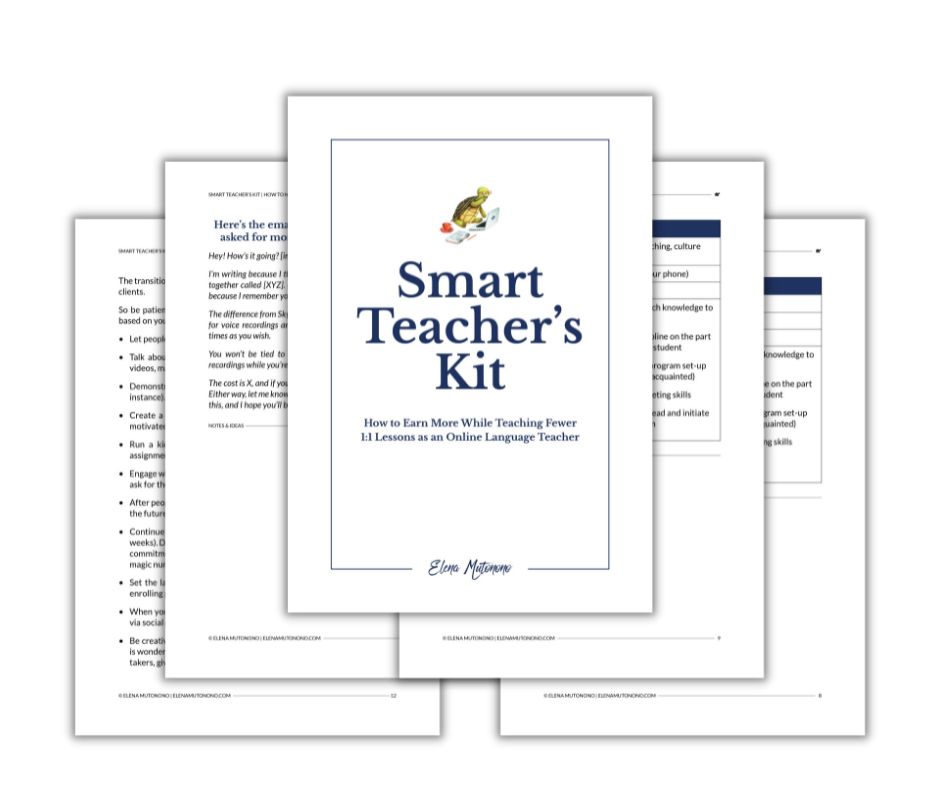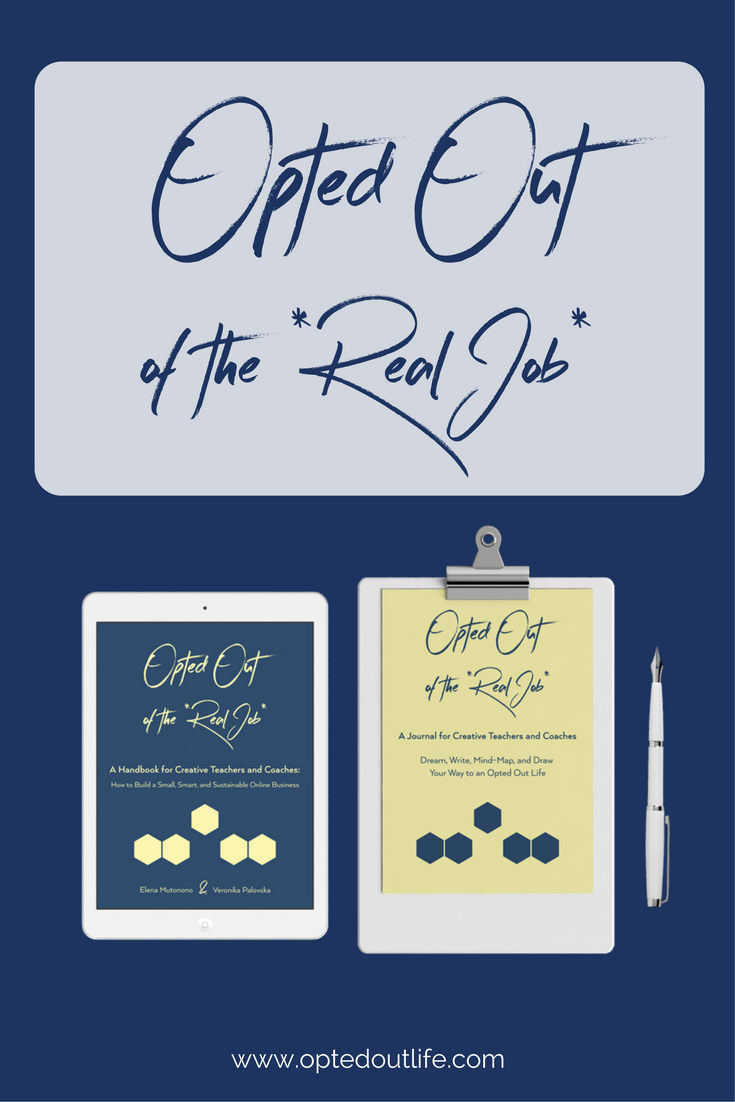Which scheduling system is better, Acuity or Calendly? I remember asking this question myself when I was first getting started with my online coaching business. Fortunately, I’m a member of Elena’s Smart Teacher’s Library, a community where online teachers can find resources and support each other. Whenever I have a question about some aspect of online teaching, the Library’s Slack forum is the first place I go for advice. (BTW, it opens for enrollment on Feb. 7th.)
When I asked this question in that forum three years ago, several of my peers responded. Some shared that they preferred one scheduling system or the other and gave their reasons why, but I never felt like I got a definitive answer. So when Elena asked me to research the differences between these two systems and write a guest post, I was excited to dig in and explore.
I’m a storytelling and communication coach with a background in language teaching. So, I did this research with online language teachers in mind because I’ve seen other members in our community ask this very question. I remember feeling overwhelmed by all the choices I had to make to get my business up and running, and sometimes you just don’t know what you don’t know. So, I’m hoping this post can not only make your decision easier but also ensure that you’re considering all the important factors when choosing between these two systems.
The features
When I made my decision three years ago, I went with Calendly because they have a free plan. When I was just starting out, my budget was tight and the free plan was enough, but eventually I realized there were additional features I wanted to have access to. I upgraded to their Professional Plan, which costs $15/mo. I’m comparing it to the Acuity Emerging plan, which is $14/mo. This is the cheapest plan Acuity offers, and includes a 7-day free trial. Calendly also has a Basic plan for $8, but I want to compare apples to apples, and I think the Professional and Emerging plans are the most similar.
I first considered comparing all the features here, but there are a lot of options for each scheduling system. I didn’t want to overwhelm or bore folks with all that data. Instead, I’ll focus on what I feel might be the most burning questions for the typical online language teacher and share what the experience of using these systems is like. If you just want to compare a list of features, here are the links to Calendly and Acuity’s pricing pages.
At the $14/15 plan level, the features of these two systems are fairly similar. Both offer unlimited appointment types, custom branding, calendar integration, email confirmations and reminders. Both offer group events, options for accepting payments, and live chat support. Acuity’s plan allows you to create coupons and upsells, includes accounting and invoicing features, and database management. They also provide Square as a payment option. So if those specific features are important to you, Acuity is your plan. By contrast, only Calendly offers text reminders and workflows at this plan level, so that might be the deciding factor for you.
The dashboard experience
Features, however, are not the only consideration when making a decision about your scheduling system. The user experience can also be an important factor, especially if you are not really a “techie” person. So, I’ve created a video overview that shows the dashboard experience for both Calendly and Acuity. In it, I go quickly through all the main screens and talk about what they do and how you might use them. I personally find the design of Calendly more intuitive and user-friendly, but you may not. This overview will allow you to get a feel for using these systems to help you decide which is the best fit for you.
As you’ll see, Calendly’s design is much simpler, but Acuity offers more features and more control. So if you’re the kind of person who’s easily overwhelmed by a complex site, that difference may be important to you. Likewise, if you’re the kind who likes to really control and customize every aspect of their experience, you may see a clear choice here.
The event options
In the third and fourth sections of the video, I walk you through all the different options available when creating events in Calendly and Acuity. I also show what the customized calendar screen looks like for potential clients in each scheduling system.
The four sections of this video
0:00 Overview of the Calendly dashboard
4:57 Overview of the Acuity dashboard
12:52 Demo of the Calendly Event Options
16:58 Demo of the Acuity Event Options
\Which scheduling system is better, Acuity or Calendly? I remember asking this question myself when I was first getting started with my online coaching business. Fortunately, I’m a member of Elena’s Smart Teacher’s Library, a community where online teachers can find resources and support each other. Whenever I have a question about some aspect of online teaching, the Library’s Slack forum is the first place I go for advice. (BTW, it opens for enrollment on Feb. 7th.)
When I asked this question in that forum three years ago, several of my peers responded. Some shared that they preferred one scheduling system or the other and gave their reasons why, but I never felt like I got a definitive answer. So when Elena asked me to research the differences between these two systems and write a guest post, I was excited to dig in and explore.
I’m a storytelling and communication coach with a background in language teaching. So, I did this research with online language teachers in mind because I’ve seen other members in our community ask this very question. I remember feeling overwhelmed by all the choices I had to make to get my business up and running, and sometimes you just don’t know what you don’t know. So, I’m hoping this post can not only make your decision easier but also ensure that you’re considering all the important factors when choosing between these two systems.
The features
When I made my decision three years ago, I went with Calendly because they have a free plan. When I was just starting out, my budget was tight and the free plan was enough, but eventually I realized there were additional features I wanted to have access to. I upgraded to their Professional Plan, which costs $15/mo. I’m comparing it to the Acuity Emerging plan, which is $14/mo. This is the cheapest plan Acuity offers, and includes a 7-day free trial. Calendly also has a Basic plan for $8, but I want to compare apples to apples, and I think the Professional and Emerging plans are the most similar.
I first considered comparing all the features here, but there are a lot of options for each scheduling system. I didn’t want to overwhelm or bore folks with all that data. Instead, I’ll focus on what I feel might be the most burning questions for the typical online language teacher and share what the experience of using these systems is like. If you just want to compare a list of features, here are the links to Calendly and Acuity’s pricing pages.
At the $14/15 plan level, the features of these two systems are fairly similar. Both offer unlimited appointment types, custom branding, calendar integration, email confirmations and reminders. Both offer group events, options for accepting payments, and live chat support. Acuity’s plan allows you to create coupons and upsells, includes accounting and invoicing features, and database management. They also provide Square as a payment option. So if those specific features are important to you, Acuity is your plan. By contrast, only Calendly offers text reminders and workflows at this plan level, so that might be the deciding factor for you.
The dashboard experience
Features, however, are not the only consideration when making a decision about your scheduling system. The user experience can also be an important factor, especially if you are not really a “techie” person. So, I’ve created a video overview that shows the dashboard experience for both Calendly and Acuity. In it, I go quickly through all the main screens and talk about what they do and how you might use them. I personally find the design of Calendly more intuitive and user-friendly, but you may not. This overview will allow you to get a feel for using these systems to help you decide which is the best fit for you.
As you’ll see, Calendly’s design is much simpler, but Acuity offers more features and more control. So if you’re the kind of person who’s easily overwhelmed by a complex site, that difference may be important to you. Likewise, if you’re the kind who likes to really control and customize every aspect of their experience, you may see a clear choice here.
The event options
In the third and fourth sections of the video, I walk you through all the different options available when creating events in Calendly and Acuity. I also show what the customized calendar screen looks like for potential clients in each scheduling system.
The four sections of this video
0:00 Overview of Calendly dashboard
4:57 Overview of Acuity dashboard
12:52 Demo of Calendly Event Options
16:58 Demo of Acuity Event Options
The final analysis
In my opinion, one of the most significant differences between the features of these two systems comes at the higher plan levels. If you want to be able to sell packages, memberships, or subscriptions, these options are only possible with Acuity’s Growing plan ($23/mo.). These are features that a lot of online language teachers may want, so I feel I should call that out.
According to Calendly, their system is much better for teams. So, if you work in tandem with other teachers, you may want to explore their options for routing forms, collective events, and coordination with other team members. They have also written an article explaining what they see as the differences between these two systems if you want another viewpoint.
I’ve been very happy with my Calendly experience thus far, and I greatly prefer the user experience of their scheduling system. However, my business is at the point where I would like to have the ability to use coupons and subscription options for my payments, so I may be making the switch to Acuity in the near future. It’s not an easy decision to make, but I hope this post has helped.
Finally, if you’re interested in becoming a part of the Smart Teacher’s Library, enrollment will be opening again on February 7th. It’s a great resource for online language teachers, and a place where we can ask each other for this kind of advice and get support 24/7. It’s a wonderful community, and we’d love to have you join us!

Guest Author: Jess Gardner
I’ve been an online coach since 2017, and a member of the Smart Teacher’s Library since 2019. I help designers tell their stories more effectively in their portfolios, presentations, and interviews so they can succeed faster. I also provide graphic design and web design support for Elena and her Library. You can contact me with questions about this post or the kind of help I offer.



 Welcome to my nook where *Big Magic* happens. My name is Elena Mutonono, I help small business owners package their services as digital products and sell them online. I want you to work smarter, not harder. Increase your impact beyond your current face-to-face clients. Grow your business as you reach more people all over the world.
Welcome to my nook where *Big Magic* happens. My name is Elena Mutonono, I help small business owners package their services as digital products and sell them online. I want you to work smarter, not harder. Increase your impact beyond your current face-to-face clients. Grow your business as you reach more people all over the world.







